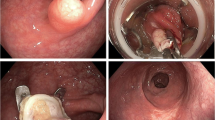Abstract
Background
There is no literature that mainly searched for rectal neuroendocrine tumor (rNET) using transanal minimal invasive surgery (TAMIS). We report our clinical experiences of TAMIS for rectal neuroendocrine tumors to evaluate the feasibility and safety.
Methods
Between December 2010 and March 2020, the 25 consecutive patients with rectal neoplasma underwent the TAMIS procedure performed by single laparoscopic surgeon at the two hospitals. Of these, ten patients with rectal neuroendocrine tumors were reviewed retrospectively. The full-thickness excision down to the outer fatty tissues was completed using TAMIS technique. Clinicopathological findings, perioperative and postoperative complications were recorded.
Results
TAMIS for small rNET was successfully completed in all cases. There were seven cases with a tumor size of less than 10 mm, and three cases with a tumor size between 10 and 15 mm. Six patients underwent the primary tumor excision; the remaining four patients underwent resection for the scar after endoscopic procedure. The median surgical duration was 80.5 (53–124) minutes and the median blood loss was 1 (1–12) ml. All removed tumors in the 6 primary excisions were diagnosed as neuroendocrine tumor G1. The margins of specimens were completely free in all cases. Among the four patients after endoscopic procedure, all had no histological evidence of residual tumor. The median length of hospital stay was 7 days postoperatively. There was no post-operative mortality or severe complication. The median length of observation was 54 months. No recurrence, no local or distant metastasis and no mortality of all patients were observed.
Conclusions
TAMIS is safety and feasible procedure for small rNET. Further experience and clinical trials are needed to fully define the advantages, disadvantages, and indications of TAMIS for rNET.





Similar content being viewed by others
References
Tsikitis VL, Wertheim BC, Guerrero MA (2012) Trends of incidence and survival of gastrointestinal neuroendocrine tumors in the United States: a seer analysis. J Cancer 3:292–302
Basuroy R, Haji A, Ramage JK, Quaglia A, Srirajaskanthan R (2016) Review article: the investigation and management of rectal neuroendocrine tumours. Aliment Pharmacol Ther 44:332–345
Modlin IM, Lye KD, Kidd M (2003) A 5-decade analysis of 13,715 carcinoid tumors. Cancer 97:934–959
Pan J, Zhang X, Shi Y, Pei Q (2018) Endoscopic mucosal resection with suction vs. endoscopic submucosal dissection for small rectal neuroendocrine tumors: a meta-analysis. Scand J Gastroenterol 53:1139–1145
Atallah S, Albert M, Larach S (2010) Transanal minimally invasive surgery: a giant leap forward. Surg Endosc 24:2200–2205
Albert MR, Atallah SB, deBeche-Adams TC, Izfar S, Larach SW (2013) Transanal minimally invasive surgery (TAMIS) for local excision of benign neoplasms and early-stage rectal cancer: efficacy and outcomes in the first 50 patients. Dis Colon Rectum 56:301–307
Lee L, Burke JP, deBeche-Adams T, Nassif G, Martin-Perez B, Monson JRT, Albert MR, Atallah SB (2018) Transanal minimally invasive surgery for local excision of benign and malignant rectal neoplasia: outcomes from 200 consecutive cases with midterm follow up. Ann Surg 267:910–916
Lim SB, Seo SI, Lee JL, Kwak JY, Jang TY, Kim CW, Yoon YS, Yu CS, Kim JC (2012) Feasibility of transanal minimally invasive surgery for mid-rectal lesions. Surg Endosc 26:3127–3132
Lee TG, Lee SJ (2014) Transanal single-port microsurgery for rectal tumors: minimal invasive surgery under spinal anesthesia. Surg Endosc 28:271–280
McLemore EC, Weston LA, Coker AM, Jacobsen GR, Talamini HS, Ramamoorthy SL (2014) Transanal minimally invasive surgery for benign and malignant rectal neoplasia. Am J Surg 208:372–381
Chen N, Peng YF, Yao YF, Gu J (2018) Trans-anal minimally invasive surgery for rectal neoplasia: experience from single tertiary institution in China. World J Gastrointest Oncol 15(10):137–144
Hayashi S, Takayama T, Yamagata M, Matsuda M, Masuda M (2013) Single-incision laparoscopic surgery used to perform transanal endoscopic microsurgery (SILSTEM) for T1 rectal cancer under spinal anesthesia: report of a case. Surg Today 43:325–328
Hayashi S, Takayama T, Matsuda M, Ikarashi M, Hagiwara K, Suzuki T (2014) Evaluation of three types of platforms in single-incision laparoscopic surgery for performing transanal endoscopic microsurgery (SILSTEM). Hepatogastroenterology 61:1931–1937
Canda AE, Terzi C, Sagol O, Sarioglu S, Obuz F, Fuzun M (2012) Transanal single-port access microsurgery (TSPAM). Surg Laparosc Endosc Percutan Tech 22:349–353
Verseveld M, Barendse RM, Gosselink MP, Verhoef C, de Graaf EJ, Doornebosch PG (2016) Transanal minimally invasive surgery: impact on quality of life and functional outcome. Surg Endosc 30:1184–1187
Barendse RM, Doornebosch PG, Bemelman WA, Fockens P, Dekker E, de Graaf EJ (2012) Transanal employment of single access ports is feasible for rectal surgery. Ann Surg 256:1030–1033
Haugvik SP, Groven S, Bondi J, Vågan T, Brynhildsvoll SO, Olsen OC (2016) A critical appraisal of transanal minimally invasive surgery (TAMIS) in the treatment of rectal adenoma: a 4-year experience with 51 cases. Scand J Gastroenterol 51:855–859
Sekiguchi M, Sekine S, Sakamoto T, Otake Y, Nakajima T, Matsuda T, Taniguchi H, Kushima R, Ohe Y, Saito Y (2015) Excellent prognosis following endoscopic resection of patients with rectal neuroendocrine tumors despite the frequent presence of lymphovascular invasion. J Gastroenterol 50:1184–1189
Harada H, Suehiro S, Murakami D, Nakahara R, Shimizu T, Katsuyama Y, Miyama Y, Hayasaka K, Tounou S (2017) Endoscopic submucosal dissection for small submucosal tumors of the rectum compared with endoscopic submucosal resection with a ligation device. World J Gastrointest Endosc 9:70–76
Soga J (2005) Early-stage carcinoids of the gastrointestinal tract: an analysis of 1914 reported cases. Cancer 103:1587–1595
McDermott FD, Heeney A, Courtney D, Mohan H, Winter D (2014) Rectal carcinoids: a systematic review. Surg Endosc 28:2020–2026
Funding
No funding has been obtained for this research.
Author information
Authors and Affiliations
Corresponding author
Ethics declarations
Disclosures
Shigeoki Hayashi, Tadatoshi Takayama, Masahito Ikarashi, Ken Hagiwara, Yoritaka Matsuno and Takeki Suzuki have no conflicts of interest or financial ties to disclosure.
Additional information
Publisher's Note
Springer Nature remains neutral with regard to jurisdictional claims in published maps and institutional affiliations.
Rights and permissions
About this article
Cite this article
Hayashi, S., Takayama, T., Ikarashi, M. et al. Transanal minimally invasive surgery for rectal neuroendocrine tumors. Surg Endosc 35, 6746–6753 (2021). https://doi.org/10.1007/s00464-020-08178-z
Received:
Accepted:
Published:
Issue Date:
DOI: https://doi.org/10.1007/s00464-020-08178-z




